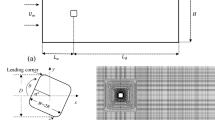Abstract
A series of experimental studies have been carried out on water entry of three-dimensional circular cylinders for low Froude numbers. In our previous paper (Wei and Hu J Mar Sci Technol, 1:1–13, 2014), the results on horizontal circular cylinders have been reported, describing several typical three-dimensional water entry phenomena and discussing the effect of length-to-diameter ratios. In this paper, the results on inclined circular cylinders are presented. The emphasis of the study is paid on the effect of inclined angles. The effects of density ratio and length-to-diameter ratio are also considered. Translational and rotational motions of the cylinder are obtained from the image analysis of the video records by a high-speed digital camera. The lift force, drag force and torque on the cylinder are then estimated using the cylinder motions. Both quantitative and qualitative analyses are carried out on the experimental results. The major observations of this study are: (1) the cylinder with lower inclined angle experiences larger maximum drag force; (2) due to initial impact, the cylinder moves along a curved trajectory in water as a result of spin-induced lift force; (3) the inclined angle also makes the surface of cylinder relatively more hydrophilic; (4) when the cavity collapses, a sudden change of the trajectories and forces appears due to the free surface impinging on the cylinder.




















Similar content being viewed by others
Explore related subjects
Discover the latest articles and news from researchers in related subjects, suggested using machine learning.References
Wei ZY, Hu CH (2014) An experimental study on water entry of horizontal cylinders. J Mar Sci Technol 1:1–13
May A, Woodhull JC (1948) Drag coefficients of steel spheres entering water vertically. J Appl Phys 19:1109–1121
May A, Woodhull JC (1950) The virtual mass of a sphere entering water vertically. J Appl Phys 21:1285–1289
Richardson EG (1948) The impact of a solid on a liquid surface. Proc Phys Soc 4:352–367
May A (1951) Effect of surface condition of a sphere on its water-entry cavity. J Appl Phys 22:1219–1222
May A (1952) Vertical entry of missiles into water. J Appl Phys 23:1362–1372
May A (1975) Water entry and the cavity-running behaviour of missiles. Final. Naval Surface Weapons Center White Oak Laboratory, Silver Springs, MD
Wagner H (1948) Planning of watercraft. NACA TM 1139
Greenhow M (1988) Water entry and exit of a horizontal circular cylinder. Appl Ocean Res 10(4):191–198
Piro DJ, Maki KJ (2013) Hydroelastic analysis of bodies that enter and exit water. J Fluids Struct 37:134–150
Khabakhpasheva T, Korobkin A (2013) Elastic wedge impact onto a liquid surface: Wagner’s solution and approximate models. J Fluids Struct 36:32–49
von Karman T (1929) The impact of seaplane floats during landing. NACA TN 321, October, Washington
Rosellini L, Hersen F, Clanet C, Bocquet L (2005) Skipping stones. J Fluid Mech 543:137–146
Glasheen JW, McMahon TA (1996) Vertical water entry of disks at low Froude numbers. Phys Fluids 8:2078–2083
Ueda Y, Uemura T, Iguchi M (2010) Entry of inclined hydrophobic and hydrophilic circular cylinders into water. J Visual 14:7–9
Worthington AM, Cole RS (1897) Impact with a liquid surface, studied by the aid of instantaneous photography. Phil. Trans R Soc Lond Ser A (Containing Papers of a Mathematical or Physical Character) 189:137–148
Abelson HI (1970) Pressure measurements in the water-entry cavity. J Fluid Mech 44:129–144
Greenhow M, Lin WM (1983) Nonlinear free surface effects: experiment and theory. Rep. 83–19. Dept. Ocean Engineering, MIT
Truscott TT, Techet AH (2009) Water-entry of spinning spheres. J Fluid Mech 625:135–165
Techet AH, Truscott TT (2011) Water entry of spinning hydrophobic and hydrophilic spheres. J Fluids Struct 27:716–726
Truscott TT, Epps BP, Techet AH (2012) Unsteady forces on spheres during free-surface water entry. J Fluid Mech 704:173–210
Truscott TT, Epps BP, Belden Jesse (2013) Water Entry of Projectiles. Annu Rev Fluid Mech 46:355–378
Cointe R, Armand JL (1987) Hydrodynamic impact analysis of a cylinder. J Offshore Mech Arct Eng 109:237–243
Oliver JM (2007) Second-order Wagner theory for two-dimensional water-entry problems at small deadrise angles. J Fluid Mech 572:59–85
Wagner H (1932) Uber Stoss-und Gleitvorgange an der Oberfluche von Flussigkeiten. Z Angew Math Mech 12:193–215
Lin MC, Shieh LD (1997) Simultaneous measurements of water impact on a two-dimensional body. Fluid Dyn Res 19:125–148
Sun H, Faltinsen OM (2006) Water impact of horizontal circular cylinders and cylindrical shells. Appl Ocean Res 28(5):299–311
Zhu X, Faltinsen OM, Hu CH (2007) Water entry and exit of a horizontal circular cylinder. J Offshore Mech Arct Eng 129:253–264
Wei ZY, Shi XH (2012) Evolution of three-dimensional cavitation formed by the water entry of an inclined cylinder. Theor Appl Mech Lett 2:022002
Raffel M, Willert C, Willert CE, Kompenhans S (1998) Particle image velocimetry. Springer, Berlin
Epps BP, Truscott TT, Techet AH (2010) Evaluating derivatives of experimental data using smoothing splines. In: 3rd Mathematical methods in engineering international symposium (MME’10), Coimbra, Portugal, October 21–24
Enriquez OR, Peters IR, Gekle S, Schmidt LE, van der Meer D, Versluis M, Lohse D (2010) Collapse of nonaxisymmetric cavities. Phys Fluids 22(9):091104
Enriquez OR, Peters IR, Gekle S, Schmidt LE, Lohse D, van der Meer D (2012) Collapse and pinch-off of a non-axisymmetric impact-created air cavity in water. J Fluid Mech 701:40–58
Duez C, Ybert C, Clanet C, Bocquet L (2007) Making a splash with water repellency. Nat Phys 3:180–183
Acknowledgments
The authors would like to thank Research Institute for Applied Mechanics, Kyushu University for supporting this study. The authors would also like to acknowledge Mr. Makoto Yasunaga, Dr. Sueyoshi Makoto, and are grateful for their help in designing and installing the experimental setup.
Author information
Authors and Affiliations
Corresponding author
About this article
Cite this article
Wei, Z., Hu, C. Experimental study on water entry of circular cylinders with inclined angles. J Mar Sci Technol 20, 722–738 (2015). https://doi.org/10.1007/s00773-015-0326-1
Received:
Accepted:
Published:
Issue Date:
DOI: https://doi.org/10.1007/s00773-015-0326-1



